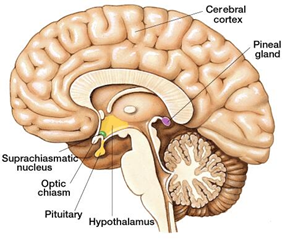The pineal gland, often referred to as the “third eye,” has fascinated scientists and philosophers for centuries because of its intriguing mistery. Nestled deep within the brain, this small, pinecone-shaped gland has been the subject of numerous studies and speculation regarding its function and significance. In this article, we will delve into the world of the pineal gland, exploring its location, function, the role of hormones it produces. Also, we’ll explore some common disorders associated with it, and its relevance in the realm of SEO search.
Location of the Pineal Gland in the Brain:
The pineal gland is located in the center of the brain, near the base of the cerebral hemispheres. Situated within the diencephalon, a region responsible for relaying sensory information, resting between the cerebral hemispheres, just above the brainstem. Its unique position makes it highly inaccessible, surrounded by a protective barrier known as the blood-brain barrier.
Function of the Pineal Gland:
The pineal gland plays a crucial role in regulating various physiological functions and is involved in the production of melatonin, a hormone responsible for regulating the sleep-wake cycle. Melatonin is produced by the pineal gland in response to darkness, and its secretion is inhibited by exposure to light.
Melatonin or “hormone of darkness,” helps synchronize the body’s internal clock with the day-night cycle. It helps regulate sleep patterns, promotes relaxation, and influences other physiological processes such as body temperature and blood pressure.

Beyond its role in regulating sleep, the pineal gland has also been associated with the concept of the “third eye” in certain spiritual and philosophical traditions. Some believe that the pineal gland serves as a gateway to higher states of consciousness and intuition. Therefore, it serves as the link between the physical and spiritual realms. While scientific research has not conclusively proven these claims, it continues to fuel fascination and intrigue surrounding this mysterious gland.
Hormones Produced by the Pineal Gland:
Apart from melatonin, the pineal gland also produces other hormones, including serotonin, norepinephrine, and dimethyltryptamine (DMT). Serotonin is a neurotransmitter known for its role in mood regulation, while norepinephrine is involved in the body’s stress response. DMT, on the contrary, is a compound with psychedelic properties and is believed to contribute to altered states of consciousness.
Disorders Associated with the Pineal Gland:
Despite its small size, the pineal gland can be susceptible to various disorders. One common condition is a pineal gland cyst, which is a fluid-filled sac that forms within the gland. Pineal cysts are usually benign and often go unnoticed, causing no symptoms. However, in some cases, larger cysts can exert pressure on surrounding structures, leading to headaches, visual disturbances, and hormonal imbalances.
Another disorder pineal gland is the pineal gland calcification, a deposit of calcium in the gland over time. This calcification is not fully understood, but it has been linked to aging, fluoride exposure, and certain medical conditions. Pineal gland calcification is a common finding in older individuals and is typically considered a normal part of the aging process. However, excessive calcification can affect the gland’s function and may be associated with sleep disorders and neurodegenerative conditions.
SEO Search and the Pineal Gland’s Location:

In recent years, the concept of the “third eye” and the pineal gland’s association with spirituality has gained traction in certain online communities. As a result, there has been an increased interest in the pineal gland’s location from an SEO (search engine optimization) perspective. People seeking information on the pineal gland often include location-related keywords to find relevant content.
For SEO search purposes, it is important to note that the pineal gland is situated deep within the brain, between the cerebral hemispheres. Although its exact location may not be as widely known as other brain structures, it is still crucial to provide accurate and informative content to address users’ queries.
Conclusion:
The pineal gland, often referred to as the “third eye,” is a small, pinecone-shaped gland located deep within the brain. It plays a vital role in regulating the sleep-wake cycle through the production of melatonin. Additionally, it produces other hormones and has been associated with spiritual and philosophical concepts.
Disorders associated with the pineal gland, such as cysts and calcification, can impact its function and lead to various symptoms. Understanding the location and function of the pineal gland is important for those seeking information and for SEO search purposes.
While the pineal gland remains a subject of ongoing scientific research and speculation, its intricate connection to our internal rhythms and potential link to higher consciousness continues to captivate the imagination. As we unravel the mysteries of the pineal gland, we inch closer to understanding its profound significance in our lives and the intricate workings of the human brain.
